Fishing Terminology
For a new cottage angler the language of fishing can be quite overwhelming.
In fact, watching a fishing program or listening to a couple of old pros banter about at the local tackle shop can make you feel like you are on a completely different planet.
This section aims to make it all a bit less confusing.
Reels
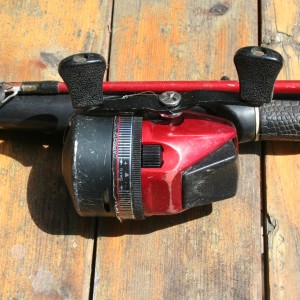
Spin Casting Reel
A closed-faced reel that uses a push-button release.
It is the easiest to use.
This is the best reel for kids and beginners.
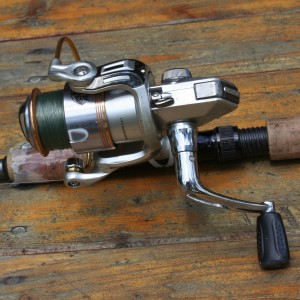
Spinning Reel
An open-faced reel that requires holding the line when casting.
It allows more accurate and longer casting than a spin-cast reel.
This is the most widely used type of reel.
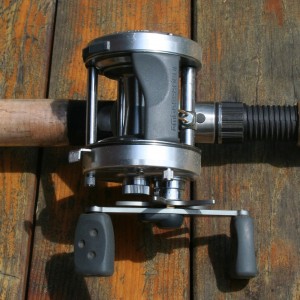
Bait Casting Reel
A hybrid system that has a semi-open face and a push-button release but requires the angler to control line tension with his/her thumb to avoid “backlash”.
This is the most accurate system with very smooth casting when used properly and is ideal for advanced anglers.
What is the “drag” on a fishing reel?
The tension setting on the fishing reel that the angler adjusts when fighting a fish is called the drag. If it is too tight, the line will break when the fish makes a run. If it is too loose, the angler will not be able to reel the fish in. When the drag is used properly, an angler can catch a large fish on very light gear.
Rods
Light Action
Provides maximum flexibility and sensitivity for detecting bites.
Used with light lines and smaller spinning reels.
Most of the weight of the fish is transferred to the rod to avoid breaking light line.
Heavy Action
A very stiff rod that is needed to “muscle” the fish out of heavy weeds or land a large fish quickly.
Used with heavy lines and bait-casting reels.
Most of the weight of the fish is placed on the line.
Medium Action
Most general purpose rods fall into this category and are recommended for beginners and casual anglers. A medium action rod is adequate for most fishing situations.
Lures
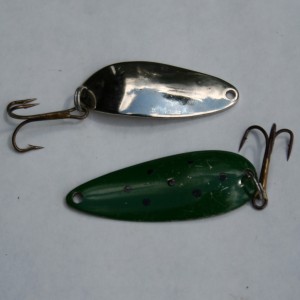
Spoons
Metal lures in the shape of the head of a table spoon.
Many are silver on one side and painted on the other.
They wobble when retrieved and are designed to resemble an injured fish.
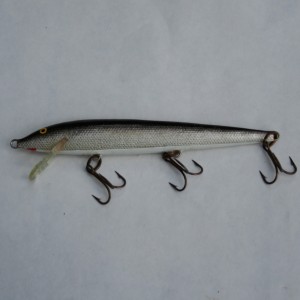
Stick-Baits
Long plastic lures that resembles a painted stick. They are sometimes jointed.
Some float, while others sink.
The style of the plastic lip on the front determines the diving depth when retrieved.
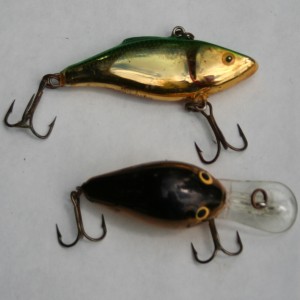
Crank-Baits or Plugs
Short, fat plastic lures that resemble fish or crayfish.
They usually dive deep. The style of the plastic lip determines the diving depth when retrieved.
Some are simply weighted and do not have a lip. They often rattle when retrieved and have an erratic wobble that varies with the speed of the retrieve.
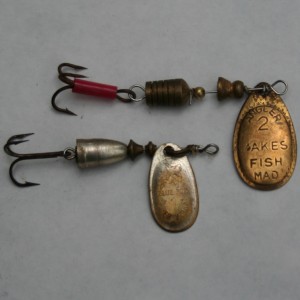
Spinner-Baits
Lures that have a metal blade that spins in the water when retrieved. These are good lures for catching all types of fish.
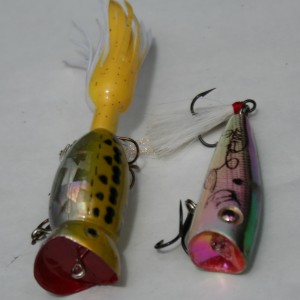
Poppers
Lures that have a concave front and are used to represent an injured fish along the top of the water.
They are “popped” along the surface by the angler.

Jig Heads and Plastics
The jig-head is a hook with a painted sinker attached.
Plastic baits or live baits are placed on the hook and the lure is fished along the bottom or cast from shore using a slow rise-and-fall retrieve.
Weights and Sinkers
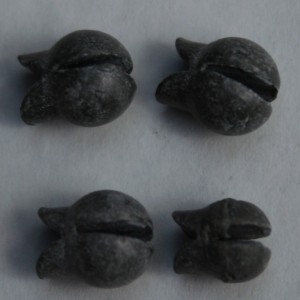
Split-Shot
A small round weight that has a gap cut into it.
The line is placed in the gap and the weight is pinched until it is fixed on the line.
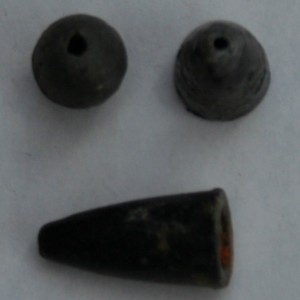
Slip Sinker
An egg-shaped or bullet-shaped weight with a hole drilled through the middle.
The line is run through the hole.
This allows the fish to take the bait without sensing the weight on the bottom.
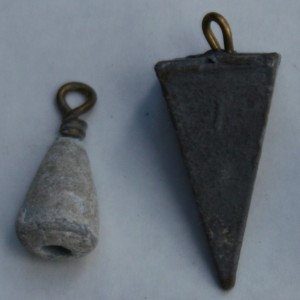
Pyramid and Bell Sinker
A triangular weight often used for fishing in strong current conditions or deep water where there is a sandy or muddy bottom.
Types of Fishing Line
Monofilament
Plastic line used with spin-casting and spinning reels.
Braided
Finely braided material line used with bait-casting reels.
Fluorocarbon
Mostly used for fly fishing and in salt water.
Pounds Test
Refers to the strength of the fishing line. It is the maximum weight the line will support without breaking. Monofilament line increases in diameter as the strength increases. The line must be properly matched with the reel and rod.
4 to 6 pound line
Used for light lures or bait with minimal weight, smaller fish, clear water conditions, thin or no weeds.
8 to 10 pound line
Used for small to medium sized lures or bait, medium sized fish, murky water, moderate to heavy weeds.
12 pound line and up
Used for heavy lures or bait, bigger fish, and conditions with heavy weeds and sunken trees or brush piles.
Other Fishing Terminology

Fishing Hook Sizes
The bigger the number, the smaller the hook.
A number four hook is a good general purpose size.
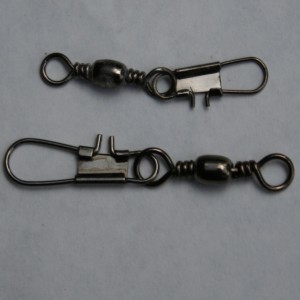
Swivels
Small metal clips placed between the line and the lure to allow the lure to rotate freely without twisting the line.
These are useful when you change the lure often while trying to find the best bait to catch fish on a particular day.

Leaders
A leader is an extra piece of line or wire that is used at the end of the main fishing line. The leader is often a much heavier test rating than the main line. Wire leaders are commonly used when you are trying to catch fish that have sharp teeth such as northern pike.

Floats and Bobbers
Bobbers or Floats are used when you want to present the bait at a specific depth below the surface of the water. The bobber is attached to the line at the desired length and cast out into the water. When a fish bites the bait the float will “bob” up and down or even get pulled under the surface of the water.
Trolling
Trolling involves letting the fishing line out behind the boat and slowly towing it along as you move through areas that you believe hold fish. The size and weight of the fishing lure along with the amount of line you let out will determine the depth that the lure runs at varying boat speeds.
Jigging
Jigging refers to fishing straight down below a boat, dock, or through the ice. It is often used with live bait but also effective with rubber baits, spoons, and jigs. The technique is to lift the bait periodically about one or two feet and let it fall back to the original depth, hopefully attracting the fish in the process. Jigging is often done near the bottom of the lake. The fish often take the bait as it it falling.
Snag
A snag occurs when your bait or sinker gets caught on an obstacle under the water. It could be a weed, rock, sunken tree, or a foreign object.
A snagged fish is a fish that has been hooked by accident through a part of the body other than the mouth.
What does it mean to get”skunked” when fishing?
You get skunked when you go fishing but do not catch any fish.
Go to the Beginner Fishing Equipment page.
Go to the Beginner Fishing Tips page.
Go to the Fishing Knots page.




